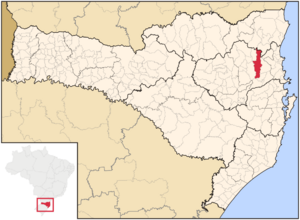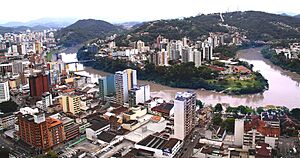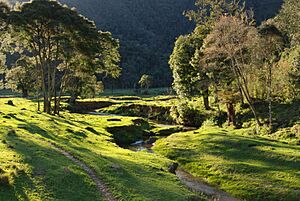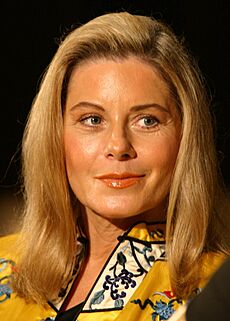Blumenau facts for kids
Quick facts for kids
Blumenau
|
|||
|---|---|---|---|
|
Municipality
|
|||
| Municipality of Blumenau | |||
|
|
|||
|
|||
| Nickname(s):
Cidade Jardim ("Garden City") and Alemanha Tropical ("Tropical Germany")
|
|||
| Motto(s):
Pro Sancta Catharina et Brasilia (Latin)
|
|||

Location in Santa Catarina
|
|||
| Country | |||
| Region | South | ||
| State | |||
| Founded | September 2, 1850 | ||
| Named for | Hermann Blumenau | ||
| Area | |||
| • Total | 519.837 km2 (200.710 sq mi) | ||
| Elevation | 21 m (69 ft) | ||
| Population
(2020)
|
|||
| • Total | 361,855 | ||
| • Density | 696.0932/km2 (1,802.873/sq mi) | ||
| Time zone | GMT-3 | ||
| Postal code |
89000-000
|
||
| Area code(s) | +55 47 | ||
| HDI (2010) | 0.806 – very high | ||
Blumenau is a city in the Vale do Itajaí region of Santa Catarina state, in the southern part of Brazil. It is about 130 km (81 mi) from Florianópolis, the state capital.
The city was started by a German chemist and pharmacist named Hermann Blumenau in 1850. He arrived by boat on the Itajaí-Açu River with seventeen other Germans. Blumenau still celebrates its German roots, even hosting the second largest Oktoberfest in the world!
Contents
History of Blumenau
Blumenau was founded on September 2, 1850. Hermann Blumenau and seventeen other German immigrants started the settlement. Later, a famous biologist named Fritz Müller, who supported Darwinian Evolution, also arrived.
The city's history is shaped by German immigrants who settled in the rich lands of the Atlantic Forest. Hermann Blumenau was interested in helping European immigrants. In 1845, he agreed to represent a group that helped German people move. He traveled to Brazil to find new places for Germans to live.
He explored the Itajaí Valley very carefully. After making plans, Hermann Blumenau went back to Germany to find more immigrants. On September 2, 1850, he returned to the area with the first seventeen immigrants. Even with challenges like floods and wild animals, the settlement grew. The Brazilian government helped these first immigrants a lot. They gave them land, homes, animals, seeds, education, and healthcare. Sometimes, it was even free.
On February 4, 1880, Blumenau officially became a municipality. It had about 13,000 people living there at that time.
People of Blumenau
As of 2020, Blumenau had an estimated population of 361,855 people. The city covers an area of 519 square kilometers (200 sq mi). Most people in Blumenau have German and Italian backgrounds.
The city shows its heritage in many ways. You can see houses and buildings built in traditional German styles. There are also statues and memorials that remind everyone of the city's history. Blumenau has a very high Human Development Index (HDI) of 0.806 as of 2010. This means it's a great place to live, with good education and healthcare.
Who Lives Here?
The people of Blumenau come from different backgrounds. Here's a look at the main groups:
- Source: 2022 census
| Race/Skin color | Percentage | Number |
| White | 79.0% | 285,354 |
| Pardo (Mixed-race) | 17.1% | 61,684 |
| Black | 3.7% | 13,272 |
| Asian | 0.2% | 580 |
| Indigenous | 0.1% | 367 |
Religions in Blumenau
Most people in Blumenau follow Christian religions. Here's a look at the main religions:
- Source: 2010 IBGE Census
| Religion | Percentage | Number |
| Catholics | 73.90% | 193,474 |
| Protestants | 22.13% | 57,935 |
| No religion | 1.22% | 3,200 |
| Kardecists | 0.72% | 1,894 |
Geography and Climate
Where is Blumenau?
The city of Blumenau is in a valley. The Itajaí-Açu River flows through the middle of it. Hills covered with forests surround the valley. The lower parts of the city, including the downtown area with tall buildings, can sometimes experience floods.
Blumenau's first recorded flood happened in 1880. The city has learned a lot from past floods. Today, Blumenau is much better prepared for them. Many people choose to live in higher areas on the hills to avoid any flooding.
Blumenau's Weather
Blumenau has a humid subtropical climate. This means it's a mix between the hot, wet weather of tropical Brazil and the milder weather of places like Argentina. The city is south of the Tropic of Capricorn.
Winters in Blumenau are mild, with average temperatures around 16.6 °C (61 °F). Summers are hot and humid, with high temperatures usually around 30 °C (87 °F). Sometimes, it can even snow! On July 23, 2013, the city center saw a mix of snow and rain. Higher neighborhoods had real snow on the ground.
| Climate data for Blumenau (1976–2005) | |||||||||||||
|---|---|---|---|---|---|---|---|---|---|---|---|---|---|
| Month | Jan | Feb | Mar | Apr | May | Jun | Jul | Aug | Sep | Oct | Nov | Dec | Year |
| Mean daily maximum °C (°F) | 31.9 (89.4) |
31.6 (88.9) |
30.5 (86.9) |
27.9 (82.2) |
24.9 (76.8) |
22.5 (72.5) |
22.3 (72.1) |
23.3 (73.9) |
24.0 (75.2) |
26.1 (79.0) |
28.5 (83.3) |
30.7 (87.3) |
27.0 (80.6) |
| Daily mean °C (°F) | 24.5 (76.1) |
24.4 (75.9) |
23.2 (73.8) |
21.0 (69.8) |
18.1 (64.6) |
16.2 (61.2) |
15.5 (59.9) |
16.4 (61.5) |
17.9 (64.2) |
19.6 (67.3) |
21.5 (70.7) |
23.4 (74.1) |
20.1 (68.3) |
| Mean daily minimum °C (°F) | 20.2 (68.4) |
20.3 (68.5) |
19.5 (67.1) |
17.1 (62.8) |
14.1 (57.4) |
12.4 (54.3) |
11.6 (52.9) |
12.4 (54.3) |
14.2 (57.6) |
15.9 (60.6) |
17.3 (63.1) |
18.9 (66.0) |
16.2 (61.1) |
| Average precipitation mm (inches) | 250.0 (9.84) |
222.0 (8.74) |
162.0 (6.38) |
101.0 (3.98) |
115.0 (4.53) |
111.0 (4.37) |
99.0 (3.90) |
100.0 (3.94) |
167.0 (6.57) |
163.0 (6.42) |
157.0 (6.18) |
176.0 (6.93) |
1,823 (71.78) |
| Average relative humidity (%) | 82 | 84 | 84 | 85 | 86 | 87 | 86 | 85 | 85 | 84 | 81 | 81 | 84 |
| Mean monthly sunshine hours | 165 | 153 | 165 | 148 | 144 | 123 | 136 | 133 | 93 | 117 | 141 | 161 | 1,679 |
| Source 1: Empresa Brasileira de Pesquisa Agropecuária (EMBRAPA) | |||||||||||||
| Source 2: Climatempo (precipitation) | |||||||||||||
What Blumenau Does
Blumenau's main business is the textile industry. Big clothing companies like Cia. Hering, Karsten, and Teka are located here.
Another important area is information technology (IT). Blumenau is sometimes called the Brazilian Silicon Valley. Many successful software companies started here, often from places like Blusoft and Instituto Gene which help new businesses grow. Blumenau also makes metal, mechanical, and electrical equipment.
The city has a strong economy thanks to its busy shops, services, and tourism. It hosts important international events, usually at the Vila Germânica (German Village Park). Also, a new and growing business is making craft beer, like Eisenbahn.
Getting Around
Blumenau has a small airport called Quero-quero Airport. However, most people flying to or from Blumenau use Ministro Victor Konder International Airport. This larger airport is in a nearby town called Navegantes. Airlines like Gol Airlines, Azul Brazilian Airlines, and Latam offer bus rides between Navegantes and Blumenau. During the Oktoberfest, Azul sometimes has flights directly to Blumenau's local airport.
Fun Things to Do
Blumenau's Tourism Department has four special tour routes. These routes show different parts of the city. There are also many festivals throughout the year.
The most famous event is the Oktoberfest of Blumenau. It happens every October and brings in over a million tourists! The Oktoberfest started as a way to raise money after big floods in 1983 and 1984. Now, it's the second largest Oktoberfest in the world, after the one in Munich, Germany.
Parts of the City
Blumenau is divided into 35 neighborhoods:
- Água Verde
- Badenfurt
- Boa Vista
- Bom Retiro
- Centro
- Escola Agrícola
- Fidélis
- Fortaleza
- Fortaleza Alta
- Garcia
- Glória
- Itoupava Central
- Itoupava Norte
- Itoupava Seca
- Itoupavazinha
- Jardim Blumenau
- Nova Esperança
- Passo Manso
- Ponta Aguda
- Progresso
- Ribeirão Fresco
- Salto
- Salto do Norte
- Salto Weissbach
- Testo Salto
- Tribess
- Valparaíso
- Velha
- Velha Central
- Velha Grande
- Victor Konder
- Vila Formosa
- Vila Itoupava
- Vila Nova
- Vorstadt
Famous People from Blumenau
Many interesting people were born or lived in Blumenau:
- Hermann Blumenau (1819–1899) – The German pharmacist who founded the city.
- Emílio Henrique Baumgart (1889 in Blumenau - 1943) – An architect and engineer.
- Fritz Müller (1821 – 1897 in Blumenau) – A biologist who supported Darwin's ideas early on.
- Vera Fischer (born 1951 in Blumenau) – A famous actress.
- Rita Schadrack (1931 in Blumenau – 1988) – An actress for film, stage, and voice.
- Martin Drewes (1918 – 2013 in Blumenau) – A German military pilot and night fighter ace in WWII.
- Mariana Weickert (born 1972 in Blumenau) – A model.
- João Geraldo Kuhlmann (1882 in Blumenau - 1958) – A botanist who studied flowering plants.
- Luiz Henrique da Silveira (1940 in Blumenau – 2015) – A politician and lawyer.
- Edward af Sillén (born 1982 in Blumenau) – A Swedish screenwriter and director for film and TV.
- Armin Zimmermann (1917 in Blumenau – 1976) – A German admiral.
Sports Stars
Blumenau is also home to many athletes:
- Tiago Splitter (born 1985 in Blumenau) – A former professional basketball player.
- Tiago Volpi (born 1990 in Blumenau) – A football (soccer) goalkeeper.
- Bruna Pickler (born 1990 in Blumenau) – An athlete, actress, composer, and sports reporter.
- Ana Amorim Taleska (born 1983 in Blumenau) – A handball player.
- Christian Maicon Hening (born 1978 in Blumenau) – A football (soccer) player.
- Eduarda Amorim Taleska (born 1986 in Blumenau) – A handball player.
- Rafael Schmitz (born 1980 in Blumenau) – A football (soccer) player.
- Barbara Bruch (born 1987 in Blumenau) – A female volleyball player.
- Jean Carlo Witte (born 1977 in Blumenau) – A football (soccer) player.
- Nathan Allan de Souza (born 1996 in Blumenau) – A football (soccer) player.
- Teco Padaratz (born 1971 in Blumenau) – A former surfer and two-time champion of the WQS.
Sister Cities
Blumenau has "sister city" relationships with other cities around the world. This means they share cultural ties and friendly connections:
 Bariloche, Argentina
Bariloche, Argentina Campinas, Brazil
Campinas, Brazil Osorno, Chile
Osorno, Chile Petrópolis, Brazil
Petrópolis, Brazil Weingarten, Germany
Weingarten, Germany Posadas, Argentina
Posadas, Argentina Badajoz, Spain
Badajoz, Spain Oxapampa, Peru
Oxapampa, Peru
See also
 In Spanish: Blumenau para niños
In Spanish: Blumenau para niños


















